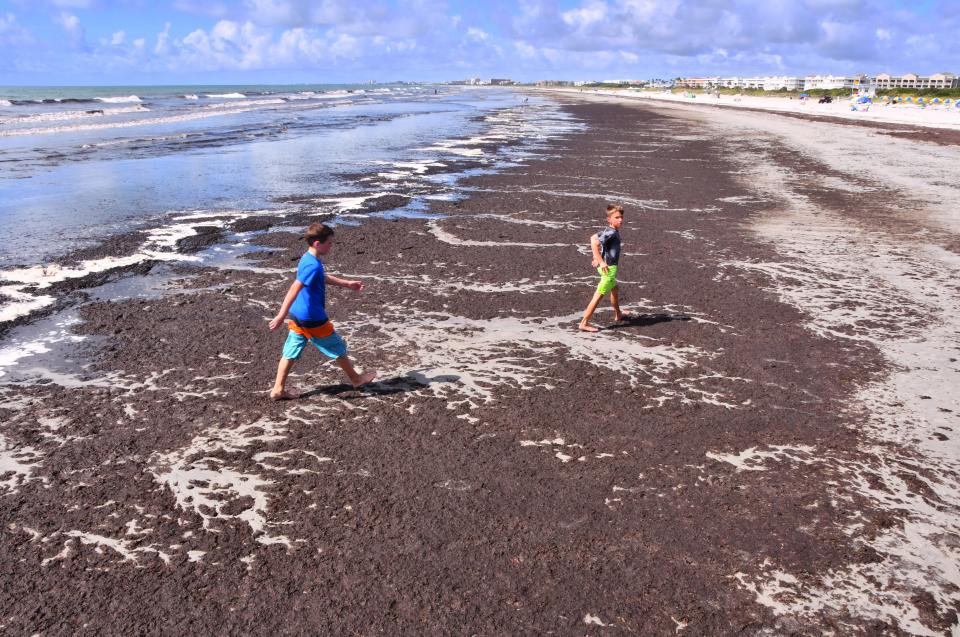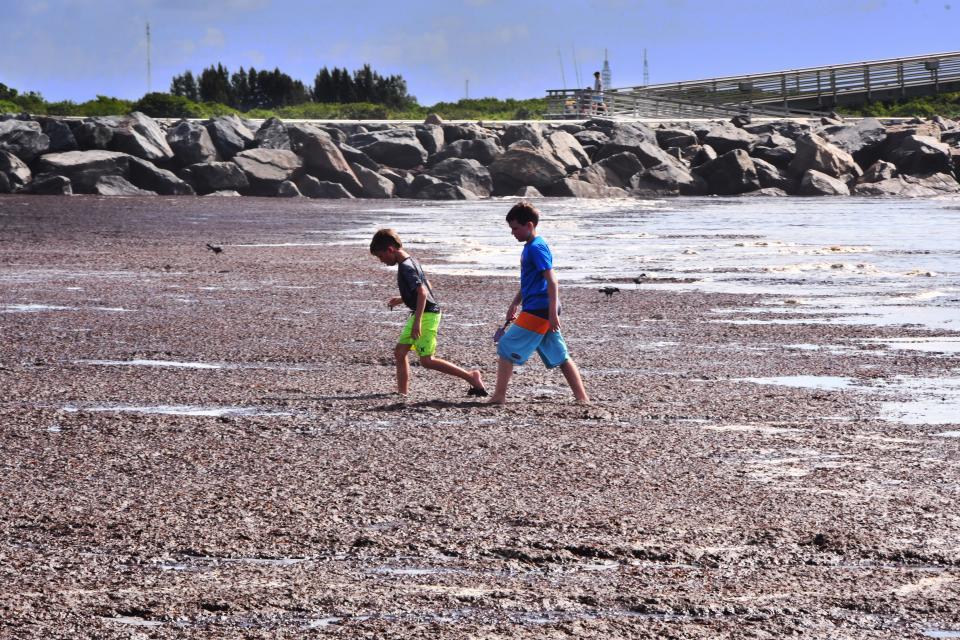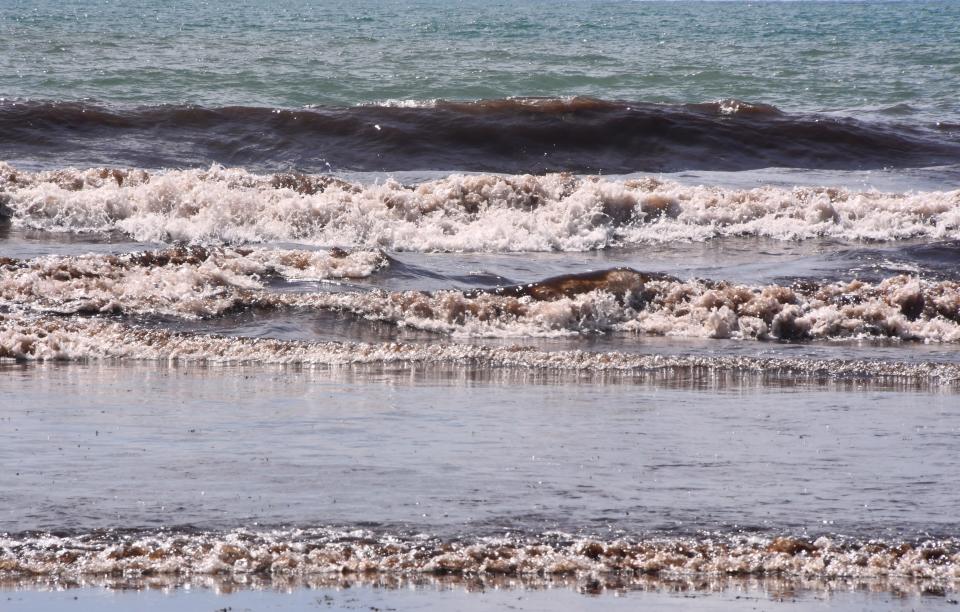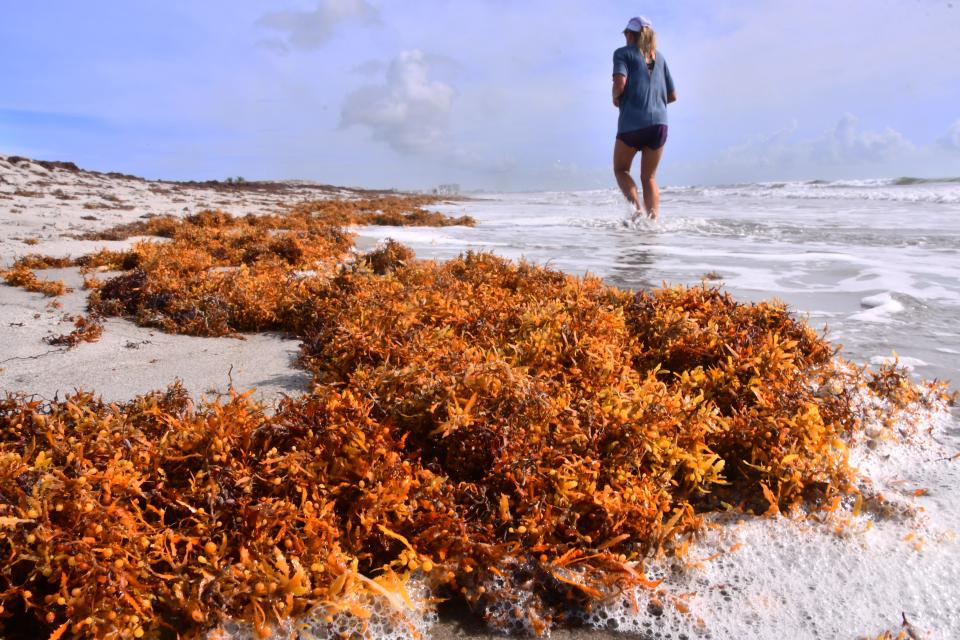'Sargassum storm': Stinky seasonal seaweed sets record in Brevard, and more is coming this way
Many people visiting the Brevard County coastline in recent days may have noticed lots of stinky seaweed that has washed up onshore. The bad news, scientists say, is that much more is headed our way than has ever been documented before.
The Caribbean Sea keeps gifting Central Florida's beaches with mounds of mushy, stinky brown seaweed. And researchers warn that this seasonal so-called Sargassum storm is likely to get worse before easing up, as all the excess weeds at sea wash in with the winds and currents, often wrapped in a filamentous brown algae that's only making things worse.

Oceanographers expect the Sargassum to thicken on beaches from the eastern Caribbean throughout Florida's east coast. So things could soon get messier, smellier and even potentially slightly toxic in the weeks to come as seaweed rots along Space Coast beaches, presenting major snags for surf fishermen and a tangled, smelly mess for other beachgoers.
"Nitrogen appears to be increasing in the Atlantic basin, driving these blooms," Brian Lapointe, a research professor at FAU-Harbor Branch in Fort Pierce. "We do believe that the Congo River is also contributing to the formation of the bloom in the eastern tropical Atlantic."
Lapointe calls Sargassum the largest seasonal algae bloom on the planet.
Seasonal seaweed strikes back: Tons of seaweed washes up on the Space Coast

For centuries, pelagic Sargassum, floating brown seaweed, have grown in low nutrient waters of the North Atlantic Ocean, supported by natural nutrient sources such as fish and invertebrates excretions and ocean upwelling. But as fertilizers, wastewater and other human source have increased the nitrogen and phosphorus into rivers, the seaweed has been growing out of control over the past decade.
FAU researchers have shown seasonal Sargassum in Florida and elsewhere in the tropical Atlantic have grown worse in recent years because of increasing nitrogen and phosphorus from discharges from the Congo, Amazon and Mississippi rivers, atmospheric deposition from Saharan dust, and biomass burning of vegetation in central and South Africa,

This summer's Sargassum already has set a record. Combined, the total amount of the weed increased from 18.8 million tons in May 2022 to 24.2 million tons in June 2022, setting a new historical record, according to the University of South Florida scientists July 2 bulletin on the algae.
Considering the historical record-high mass of Sargassum in June, more of the seagrass may enter the Caribbean Sea and the Gulf of Mexico in the following months, riding major ocean currents, USF bulletin warns. USF runs a Sargassum Watch System.
"We will keep a close eye on how Sargassum in the Caribbean Sea and the tropical Atlantic may evolve in the next two months," the bulletin says.
USF expects the trend of increasing Sargassum seaweed in the ocean to slow this month but with the possibility of ramping back up after that.
A year ago, fed by sewage and fertilizers in Brazil and thereabouts, the same seaweed kept coming all summer long. Florida Atlantic University's Harbor Branch Oceanographic Institute at the time released a study that suggested increased availability of nitrogen from natural and man-made sources, including sewage, fuels excess Sargassum growth.
According to the study, our waste can turn a critical nursery habitat into toxic algae dead zones, "with catastrophic impacts on coastal ecosystems, economies, and human health."
The FAU researchers used unique historical baseline seaweed tissue from the 1980s to compare its chemical makeup to samples collected since 2010. They found dramatic changes in the chemistry and composition of Sargassum weed since the 1980s, "transforming this vibrant living organism into a toxic “dead zone,” FAU's announcement said.
Their findings were published last year in Nature Communications.
Washed-up Sargassum: Washed-up Sargassum seaweed sometimes wreaks havoc and reeks; expect it for next several weeks
Pulled from waves: Several pulled from waves after boat capsizes near Melbourne Beach
Last month, strong winds blew a thick layer of dust from the Sahara Desert westward over the Atlantic Ocean. By June 6, the leading edge of the massive river of dust reached South America, stretching more than 3,500 miles and covering more than 2.2 million square miles, according to the Moderate Resolution Imaging Spectroradiometer (MODIS) on board NASA’s Aqua satellite, which acquired a true-color image.
Sargasso Sea
Biologists say the vegetation washing up on the Space Coast and shorelines statewide this week usually is beneficial to the beach. It provides food for birds, crabs and other wildlife and habitat for hiding. So raking the stuff off the beach can be controversial, often pitting tourism against conservation interests.
But when the weed feeds off too much sewage, it can turn toxic for some wildlife, FAU and other research shows.
Sargassum is a constant presence in the Atlantic. It typically drifts in long lines near the Gulf Stream and provides vital food for young sea turtles.
But in excess, the stuff annoys tourists and those who's livelihoods depend upon them, by fouling the beaches beauty and air.
It seems now that extreme blooms appear on an almost yearly basis, and with increasingly more toxic potential.
Sargassum contains arsenic, which it uptakes from what's naturally in ocean water. But Lapointe says arsenic levels have been increasing in the seaweed as humans have contributed more nitrogen to the environment. As we've added more nitrogen from fertilizers, sewage, deforestation and other sources to coastal waters, seaweed and other aquatic plants seek more phosphates to balance their nutrients, Lapointe explained. In doing so, the plants uptake more arsenic because its in a molecular form that's similar to phosphate.
The seaweed's proliferation is "almost like a barometer of our alteration of nitrogen cycles," Lapointe said.
Sargassum, like other seaweed, also gives off hydrogen sulfide gas as it rots, which can cause irritation to the eyes and respiratory system.

The recent stringy mess on Brevard County beaches hearkens back to the widespread Sargassum algae blooms that hit county beaches in 2014, 2015, 2018 and last year. Huge Sargassum blooms blanketed beaches along the east coast of Barbados and Puerto Rico in 2014, as well. But 2018 was among the worst in Florida, Lapointe said, adding that this year could rival that year's bloom.
"I think we're having a pretty bad year this year," Lapointe said.
Jim Waymer is an environment reporter at FLORIDA TODAY. Contact Waymer at 321-261-5903 or jwaymer@floridatoday.com. Or find him on Twitter: @JWayEnviro or on Facebook: www.facebook.com/jim.waymer
Support local journalism and local journalists like me. Visit floridatoday.com/subscribe
This article originally appeared on Florida Today: Algae bloom: Seaweed 'storm' heads for Brevard County, central Florida

